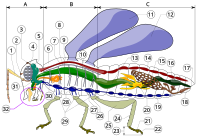
Photo from wikipedia
Abstract The effect provided by the state of the surface on the quality of the adhesion, as well as the sensitivity of the position of the locus of failure to… Click to show full abstract
Abstract The effect provided by the state of the surface on the quality of the adhesion, as well as the sensitivity of the position of the locus of failure to the surface morphology, is known to be one of the most crucial issue to be addressed when evaluating the capability of the bonded joint to withstand any mechanical stress. Therefore, the need for the substrates to undergo a pre-treatment before being bonded is to be considered. In this work, different pre-treatments were selected to be applied over aluminum and stainless steel adherents’ surfaces with the goal to produce single lap joints to undergo cyclic loading until complete failure. In particular, the experimental campaign aimed to correlate the morphology generated by the different surface pre-treatment (laser ablation, grit blasting and simple degreasing) with the quality of the fatigue performance, measured as the number of cycles to failure. Result of this research shows that the surface morphology generated by the laser ablation was able to reduce or avoid interfacial failures, leading to an increase of the fatigue performances if compared with grit blasted and degreased joints.
Journal Title: International Journal of Adhesion and Adhesives
Year Published: 2020
Link to full text (if available)
Share on Social Media: Sign Up to like & get
recommendations!